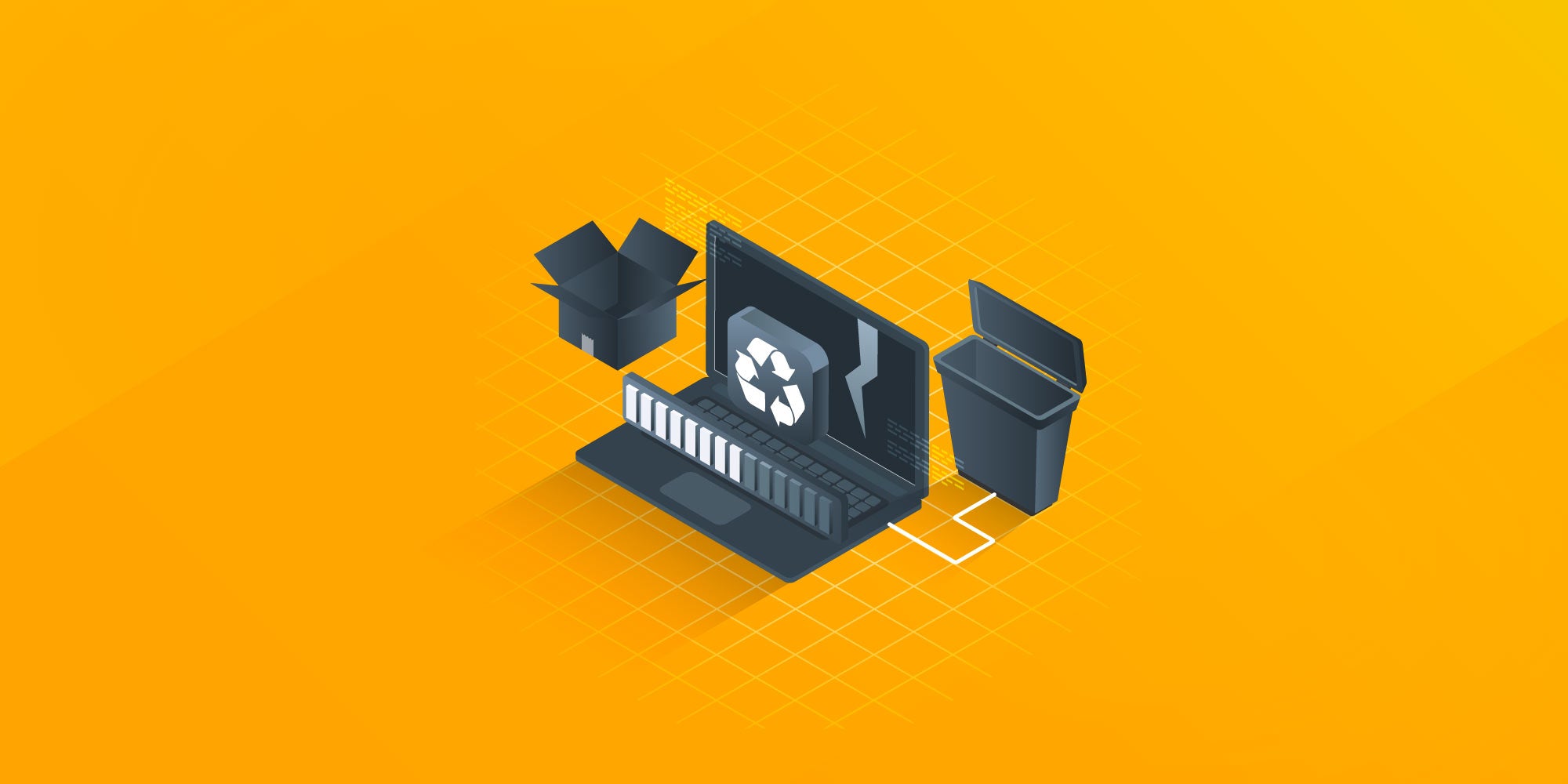The complete guide to IT Asset Disposal services
 GroWrk Team
GroWrk Team
In today’s digital-first world, technology becomes outdated faster than ever. As of 2022, global e-waste had reached 62 million metric tons, according to the United Nations, a figure that is growing by approximately 2 million tons annually. This surge makes secure IT asset disposal not just an operational need, but a critical compliance and sustainability priority.
IT Asset Disposition (ITAD) helps organizations safely retire end-of-life devices, from laptops and servers to smartphones, while minimizing environmental harm and preventing costly data breaches. IT asset disposal services also support the circular economy by minimizing waste and maximizing the reuse and recycling of IT equipment, aligning with principles that promote sustainable, regenerative practices.
Understanding IT Asset Disposition (ITAD)
.jpg?width=600&height=300&name=it%20asset%20disposal%20services%20(8).jpg)
IT Asset Disposition (ITAD) is the structured process of retiring, recycling, or repurposing outdated IT hardware in a secure, compliant, and environmentally responsible manner. IT asset disposition services are comprehensive offerings that ensure secure, compliant, and environmentally responsible management of end-of-life IT assets.
It ensures three key outcomes:
-
Data security: Preventing sensitive information leaks.
-
Regulatory compliance: Meeting global data and environmental standards.
-
Value recovery: Extracting residual value from retired assets.
A robust ITAD program involves collaboration between IT teams, compliance officers, environmental partners, and third-party vendors certified in secure disposal. The asset disposition industry is a rapidly growing sector focused on secure data destruction, environmental responsibility, and maximizing value recovery.
Asset disposition solutions help organizations maximize value recovery while minimizing environmental and security risks.
Core components of an effective ITAD program
These core services are essential to a successful ITAD program because they help to guarantee that data can be secure, compliant with regulations, and environmentally responsible during the asset lifecycle.
-
Implementing robust inventory management and inventory tracking to keep a record of all IT equipment during its lifecycle, ensuring secure and compliant asset disposition.
-
Having all the information safely backed up and erased with certified tools.
-
Getting rid of stored passwords, cloud links, and user access credentials.
-
Creating Certificates of Data Destruction and Recycling.
-
Collaborating with R2 or e-Stewards endorsed recyclers.
-
Matching the disposal indicators to environmental objectives.
Why secure IT asset disposal matters more than ever
.jpg?width=600&height=300&name=it%20asset%20disposal%20services%20(1).jpg)
As data, regulatory, and environmental risks continue to increase, it is necessary to dispose of IT assets securely to defend sensitive data, comply with regulations, and facilitate sustainable business operations.
-
Data breach risk: According to a 2023 IBM report, a data breach costs on average 4.45 million dollars, with improperly discarded devices being the common cause.
-
Regulatory compliance: Frameworks like GDPR, HIPAA, and SOX mandate secure data destruction and chain-of-custody documentation.
-
Sustainability pressure: With only 22% of global e-waste properly recycled, organizations are under increasing scrutiny to adopt circular practices.
Secure ITAD mitigates these risks and ensures data safety, while improving brand trust and operational efficiency.
Step-by-step IT asset disposal workflow
A clear, standardized disposition process is the foundation of effective IT asset management. This workflow covers the entire process from asset identification to final disposal and reporting.
Step 1: Identify and audit retired assets
Start by compiling a list of all end-of-life devices (including data-bearing devices such as hard drives, servers, and storage arrays that require special attention for secure data destruction) using asset management software. Include details like device ID, assigned user, last known location, and condition to maintain traceability.
Step 2: Backup and sanitize sensitive data
Before wiping, ensure that critical business data is safely backed up. Follow NIST 800-88 or DoD 5220.22-M data erasure standards and generate verification logs. Thorough data sanitization is essential at this stage to guarantee that all sensitive information is irretrievably removed, protecting your organization and ensuring compliance with data security regulations.
Step 3: Remove credentials and disconnect access
Erase stored credentials, delete linked accounts, and reset devices to their factory settings to prevent unauthorized access after disposal.
Step 4: Evaluate asset value and categorize
Sort hardware into:
-
Reusable / Resellable (usable equipment can be refurbished or resold to extend its lifecycle)
-
Refurbishable
-
Recyclable / Scrap (obsolete equipment should be responsibly recycled or disposed of in compliance with regulations)
This step helps in recovering maximum value and minimizing waste.
Step 5: Engage certified ITAD partners
Work only with R2, e-Stewards, or ISO 14001–certified vendors. Ensure they maintain a secure chain of custody throughout the asset disposition process by providing comprehensive chain-of-custody documentation and Certificates of Data Destruction (CoD).
Step 6: Transport and handle securely
Package devices in tamper-proof containers and use GPS-tracked logistics to prevent theft or data exposure during transport.
Step 7: Verify destruction and receive certification
After processing, vendors issue official destruction and recycling certificates. Cross-check this data against internal logs for compliance.
Step 8: Report, analyze, and optimize
Generate reports detailing recycling rates, resale profits, and carbon reduction. These reports feed into ESG dashboards and corporate sustainability goals.
Evaluating assets for responsible disposal
.jpg?width=600&height=300&name=it%20asset%20disposal%20services%20(9).jpg)
Each device should undergo a structured assessment based on.
-
Condition: Functional vs. non-functional components.
-
Data sensitivity: Devices handling critical data may require physical destruction.
-
Market value: Potential resale or parts harvesting.
-
Environmental impact: Carbon footprint of disposal options.
It is crucial to use proper disposal methods to responsibly dispose of IT assets, ensuring responsible recycling practices that meet environmental and regulatory standards.
Balancing financial recovery with environmental responsibility ensures both compliance and sustainability.
The essential IT asset disposal checklist
Before final disposal, ensure your checklist includes:
-
Complete asset inventory
-
Data backup and certified erasure
-
Credential removal and factory reset
-
Vendor certification verification
-
Proof of data destruction (CoD)
-
ESG and compliance reporting
This checklist helps maintain accountability and minimize risks during audits.
Common pitfalls in the ITAD process
Avoiding these common pitfalls is crucial to ensuring data security, regulatory compliance, and environmentally responsible IT asset disposal.
-
Failing to erase or destroy data properly leaves sensitive information exposed, increasing the risk of data breaches and compliance violations.
-
Using uncertified vendors or recyclers can result in insecure handling, non-compliance, and potential data loss.
-
Poor documentation and tracking gaps make audits difficult and reduce accountability in the ITAD process.
-
Disposing of assets without environmental compliance leads to e-waste pollution, regulatory fines, and reputational harm.
Each mistake can lead to data exposure, regulatory fines, and reputational damage.
Leveraging technology for smarter ITAD
.jpg?width=600&height=300&name=it%20asset%20disposal%20services%20(6).jpg)
By leveraging modern technologies, organizations can streamline ITAD processes, enhance data security, and maximize environmental and operational efficiency.
-
Automation: AI tools track asset lifecycles and trigger disposal schedules.
-
Blockchain: Creates immutable chain-of-custody records for transparency.
-
IoT sensors: Enable real-time tracking during transport.
-
Analytics: Help organizations optimize reuse vs. recycling ratios.
Modern ITAD programs combine automation with accountability to improve security and sustainability outcomes.
Top 7 IT asset disposal service providers
Selecting the right ITAD provider is critical for secure, compliant, and sustainable disposal of IT assets. Each provider listed below is a leading asset disposal company, offering comprehensive asset disposal services that ensure secure data destruction, environmental responsibility, and adherence to industry certifications.
|
Provider |
Overview |
|---|---|
|
GroWrk |
Automated IT lifecycle platform; AI-powered management; certified in 150+ countries. |
|
MBH Global |
Eco-friendly B Corp; certified data destruction; 10-day SLA; consult for pricing. |
|
DMD Systems |
NAID AAA & R2v3 certified; on-site destruction; zero-landfill policy; smaller global reach. |
|
ERI |
Largest U.S. ITAD provider; secure data destruction & recycling; operates in 46 countries. |
|
Sims Lifecycle Services |
Global ITAD & recycling; strong environmental focus; complex service structure. |
|
Iron Mountain |
Secure media destruction; 59 processing centers; high security & compliance; premium pricing. |
|
Dell Global Recycling Solutions |
End-to-end ITAD with sustainability; refurbishment, resale & recycling; global footprint. |
GroWrk
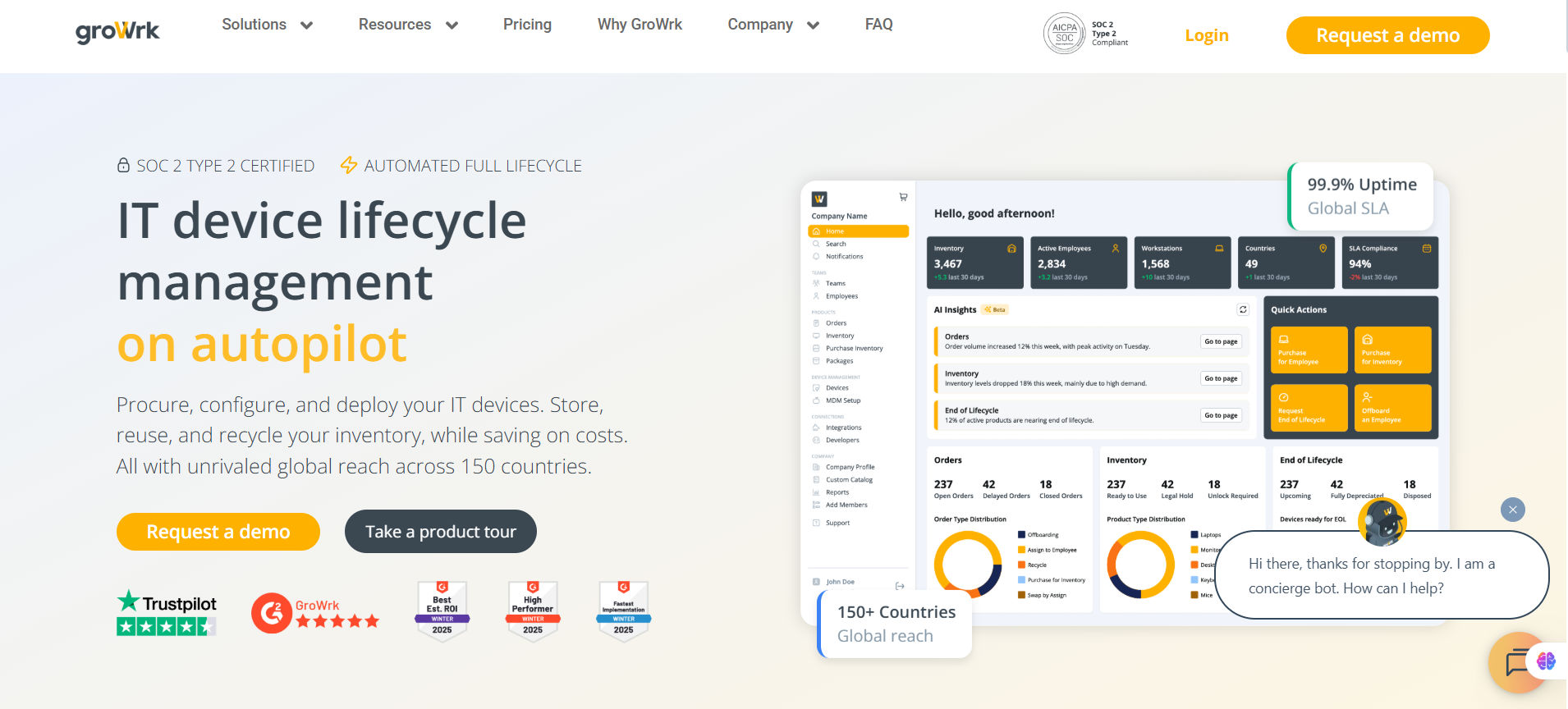
GroWrk is a comprehensive IT asset management platform designed for distributed and global teams, offering end-to-end lifecycle management that includes seamless IT asset disposal. Built for scalability across 150+ countries, it automates processes from procurement and deployment to retrieval, storage, reuse, and certified recycling or destruction, ensuring compliance and data security while minimizing manual efforts and costs for organizations with hybrid or remote workforces.
Key features
-
Full lifecycle automation, including two-click offboarding, global retrievals, and end-of-life options like recycling, reselling, or disposal directly within the platform.
-
Global inventory management with unified tracking, local compliance, and delivery within 7 business days, supported by warehouses in multiple regions.
-
Enterprise-grade security with SOC 2 Type 2 certification, automated compliance reporting, and certified data destruction for disposed assets.
-
Integrations with 40+ tools, API support, free MDM for zero-touch deployment, and AI-powered insights for asset utilization and decision-making.
-
24/7 support, 99.9% uptime, and hybrid team tools like office property management.
Pricing
Contact our sales team for a custom quote.
Pros
-
Dramatically reduces deployment and recovery time from weeks to days, streamlining global operations and cutting costs.
-
Strong focus on security and compliance, with automated reporting that simplifies audits and risk management.
-
Highly scalable for distributed teams, with intuitive interface and robust integrations that enhance productivity.
Cons
-
Requires you to pay a small one-time fee.
MBH Global
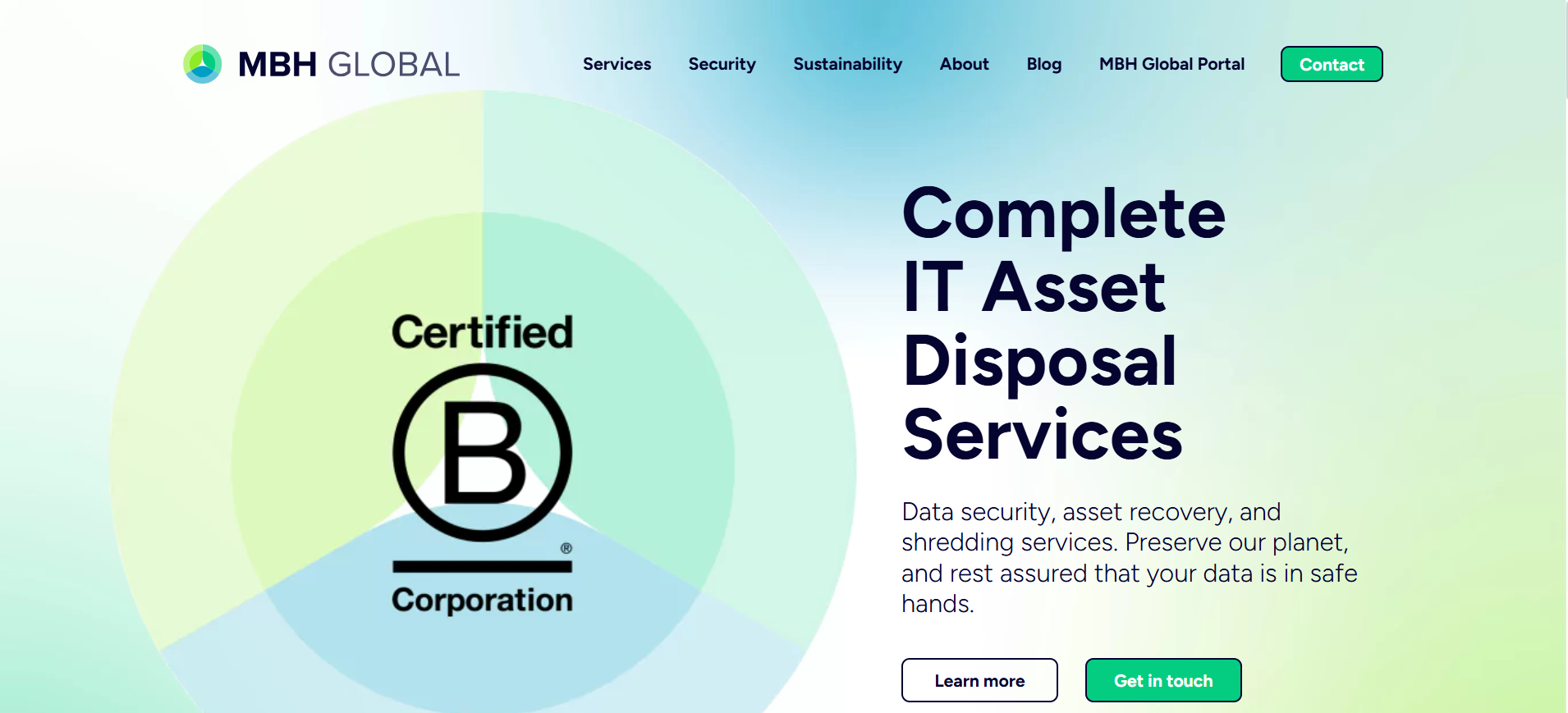
MBH Global is a Certified B Corporation specializing in secure IT asset disposition (ITAD) services, emphasizing data protection, environmental responsibility, and compliance for businesses decommissioning end-of-life IT equipment like servers, laptops, and mobiles. With a zero-to-landfill policy and global reach, it handles asset recovery, sanitization, and recycling to mitigate e-waste while providing transparent reporting, making it ideal for organizations prioritizing sustainability and regulatory adherence.
Key features
-
Secure data erasure, shredding, and destruction using industry-standard methods, with options for resale, donation, or recycling of assets.
-
Comprehensive asset tracking, auditing, and chain-of-custody documentation, including GPS monitoring and certificates of disposition.
-
Environmentally focused processes with material repurposing through certified partners, ensuring compliance with data protection laws like GDPR.
-
Flexible on-site and off-site services, with a rapid 10-day turnaround and tailored solutions for various asset types.
-
Triple-layered facility security, trained staff, and full audit trails for transparency.
Pricing
Pricing is not publicly detailed; services are customized, and clients are advised to contact for quotes based on volume and requirements.
Pros
-
Exceptional data security and compliance support, reducing breach risks with certified destruction and detailed reporting.
-
Strong sustainability credentials as a B Corp, minimizing environmental impact through reuse and zero-landfill recycling.
-
Fast turnaround and global consistency, freeing up resources and providing ROI via asset remarketing.
Cons
-
Primarily UK-focused with international capabilities, which may limit efficiency for non-European clients without additional logistics.
-
Lack of transparent pricing could complicate budgeting for smaller organizations without a quote process.
DMD Systems
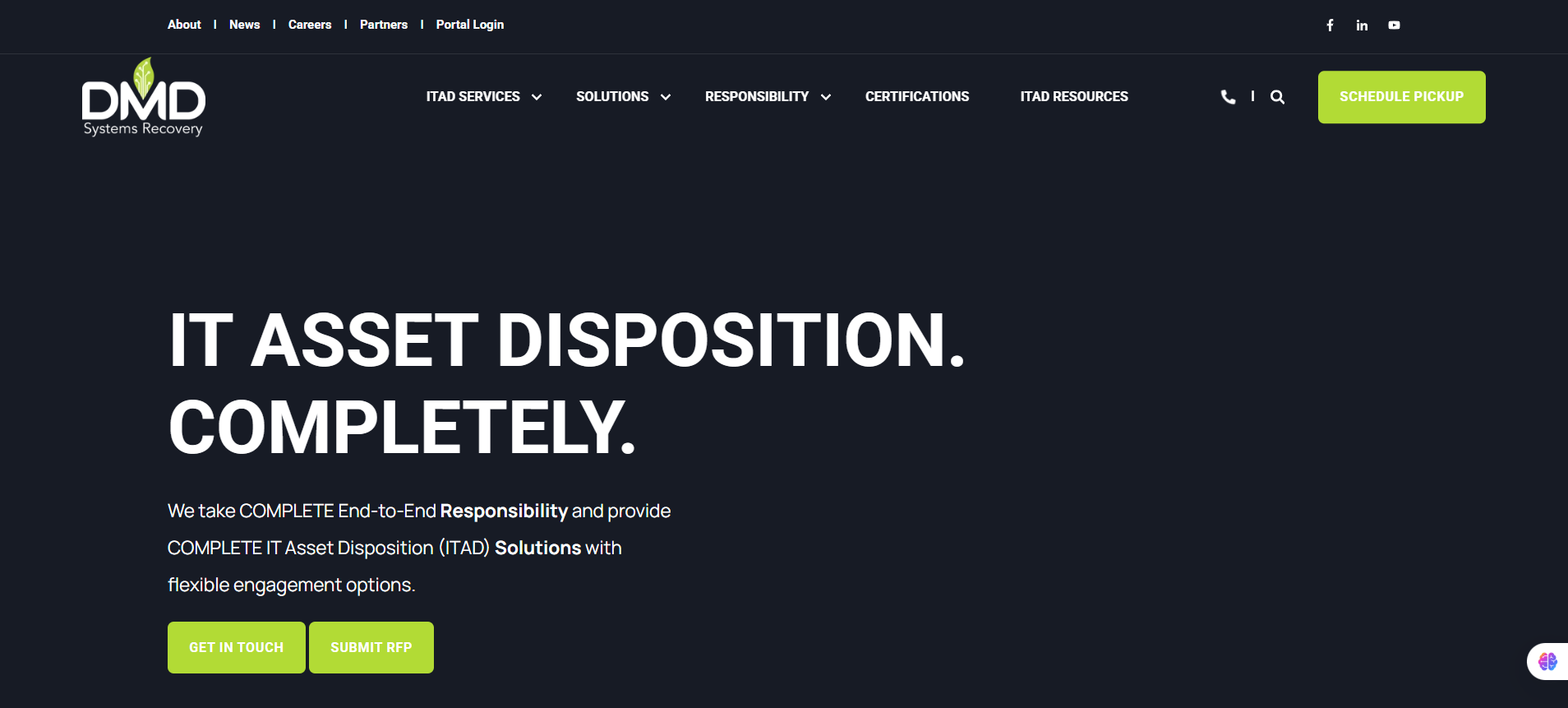
DMD Systems Recovery is a leading ITAD provider offering tailored, end-to-end solutions for decommissioning, logistics, data destruction, and remarketing of IT assets, with a "Reuse First" philosophy to extend asset lifecycles and reduce e-waste. Certified under multiple standards like NAID AAA and R2v3, it serves enterprises globally, emphasizing modular, compliant processes that balance security, sustainability, and value recovery through its national and international footprint.
Key features
-
Modular ITAD services including onsite erasure, decommissioning, transportation, inventory management, and secure data wiping with 1-7 pass options.
-
Chain-of-custody tracking with GPS, self-serve reporting portals, and certificates for destruction/recycling.
-
Transparent revenue sharing for remarketing usable assets, offsetting costs while prioritizing reuse over disposal.
-
Compliance certifications (NAID AAA, R2v3, ISO 9001/14001/45001) and B Corp status for verified environmental and social performance.
-
Custom enterprise agreements and standard reporting to validate processes and outcomes.
Pricing
Utilizes revenue share structures like Transparent Revenue Share™ to offset service costs; specific pricing is customized and not publicly listed—contact for details.
Pros
-
High flexibility and tailoring, allowing clients to assemble services to fit exact needs, with strong validation through logs and audits.
-
Commitment to sustainability via reuse focus and certifications, providing confidence in ethical disposal.
-
National/international consistency reduces risks in multi-site operations.
Cons
-
Modular approach may require more upfront planning to optimize for specific workflows compared to fully integrated platforms.
-
Revenue sharing could vary based on asset value, potentially less predictable for low-resale items.
ERI
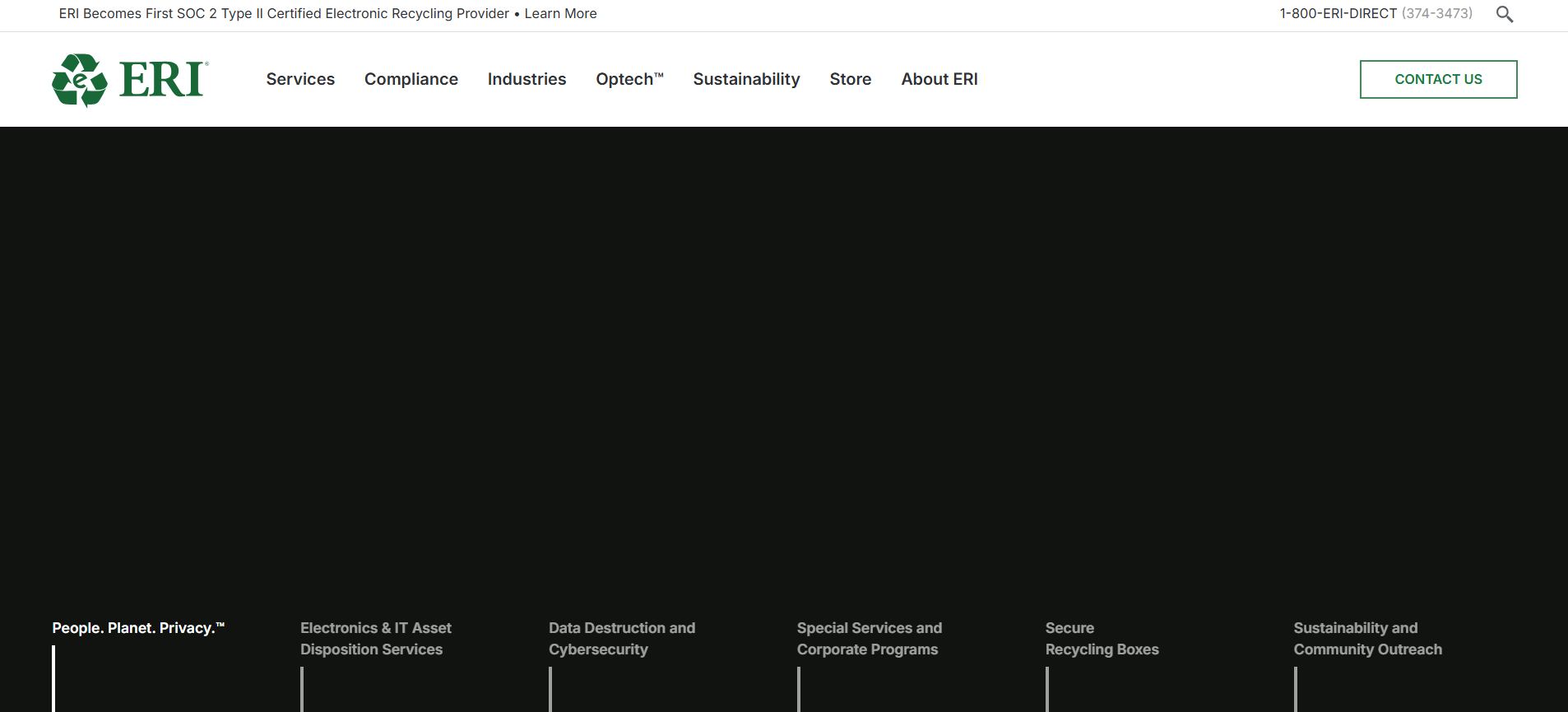
ERI is North America's largest fully integrated ITAD and electronics recycling provider, delivering secure, compliant disposition services for a wide range of devices across 46 countries and all 50 US states. With nearly 25 years of experience, it prioritizes "People. Planet. Privacy" through certified data destruction, value recovery, and sustainability metrics, serving Fortune 500s, governments, and SMEs with advanced tracking and global logistics.
Key features
-
100% certified data destruction with videographic evidence, NIST-compliant sanitization, and chain-of-custody via proprietary Optech™ software for real-time tracking.
-
Asset remarketing to recover value, plus handling for diverse devices like servers, mobiles, healthcare equipment, and e-waste.
-
ESG reporting with CO2 neutrality (achieved 2022), environmental metrics, and compliance with GDPR, HIPAA, and global regs.
-
Advanced tech like AI-driven SOAR™ for automated intake, robotics, and serialization, ensuring accuracy and efficiency.
-
Full certifications across all eight US facilities (R2v3, e-Stewards, NAID AAA, ISO standards, SOC 2 Type II) for audited processes.
Pricing
Competitive and customized; contact for quotes, with no fixed plans detailed publicly.
Pros
-
Unmatched scale and certifications build trust, with transparent tracking minimizing risks and enhancing compliance.
-
Strong sustainability focus, including real-time ESG metrics and carbon neutrality, appealing to eco-conscious organizations.
-
Efficient global coverage and tech innovations like Optech™ streamline operations and value recovery.
Cons
-
Primarily North America-centric, which may add complexity and costs for extensive non-US operations.
-
Advanced features like AI tools could involve a learning curve for smaller clients.
Sims Lifecycle Services
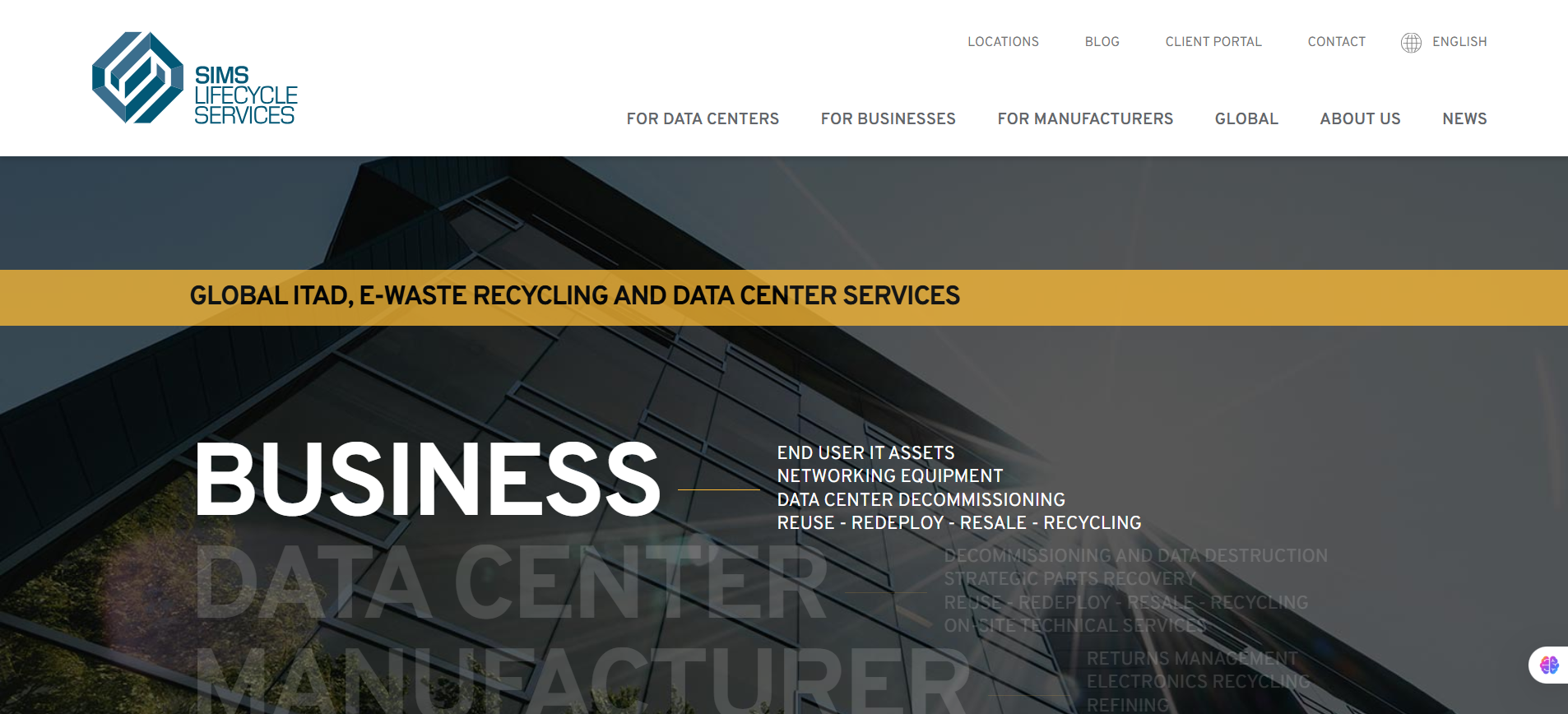
Sims Lifecycle Services (SLS) is a global leader in ITAD and e-waste recycling, offering integrated solutions for secure data destruction, asset redeployment, and value recovery to support circular economy practices. Operating 16 facilities worldwide with standardized processes, it helps enterprises standardize global IT disposal, comply with regulations, and decarbonize operations through reuse and recycling at its Circular Centers.
Key features
-
Secure erasure/destruction for all storage devices, with auditable reporting, certificates, and client portals for tracking and invoices.
-
Full lifecycle support including decommissioning, refurbishment, resale, and recycling, with MIDAS-vetted subcontractors for extended reach.
-
Compliance with ISO 9001/14001/45001/27001 and R2v3, plus cross-border logistics to avoid penalties.
-
Sustainability tools like a Carbon Calculator, ITAD Maturity Model guide, and RFP templates for program optimization.
-
Regional account management for quick responses, reducing emissions via minimized transport.
Pricing
Not publicly specified; services are enterprise-focused with customized agreements—request quotes for details.
Pros
-
Global standardization and accountability from cradle-to-grave, ensuring compliance and cost efficiencies.
-
Maximizes value recovery while prioritizing sustainability, with tools to measure environmental impact.
-
Robust auditing and subcontractor vetting provide transparency and risk reduction.
Cons
-
Focused more on large enterprises and data centers, potentially less optimized for small-scale or consumer-level disposals.
-
Extensive global processes may introduce minor delays in highly customized or urgent requests.
Iron Mountain
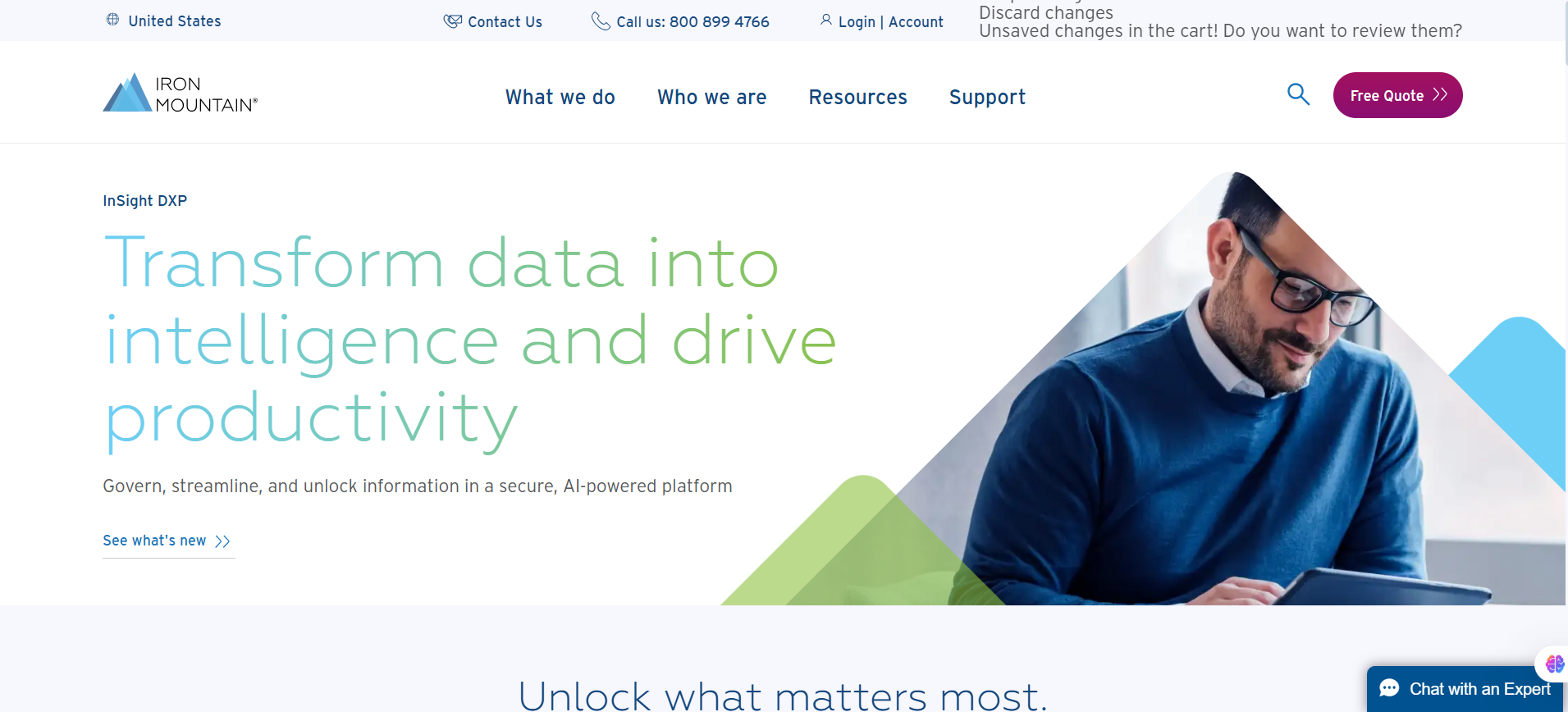
Iron Mountain's Secure IT Asset Disposition (ITAD) service provides end-to-end management for retiring corporate end-user devices, focusing on elevating data security, sustainability, and brand protection through scalable, local delivery. With 59 processing centers worldwide, it simplifies budgeting and compliance for hybrid workforces, integrating asset lifecycle management to optimize ROI and minimize environmental impact.
Key features
-
Secure data sanitization and destruction compliant with standards like NIST and NAID, with chain-of-custody tracking.
-
Value recovery through resale or recycling, plus environmental reporting for ESG goals.
-
Global network for consistent, on-site/off-site services, including decommissioning and logistics.
-
Structured budgeting with pre-approved rates and predictable costs.
-
Integration with broader ITAM for hybrid environments, emphasizing employee productivity and security.
Pricing
Offers clear, pre-approved rates for predictable budgeting; specific details require contacting for customized quotes, with potential savings from value recovery.
Pros
-
Enhances security and compliance (46% improvement noted in studies), with scalable solutions for global teams.
-
Cost-effective through predictable pricing and ROI maximization, reducing overall IT spend.
-
Strong sustainability focus, supporting circular practices and ESG reporting.
Cons
-
Primarily geared toward corporate-scale operations, which may be overkill for smaller businesses.
-
Reliance on a vast network could lead to variability in local service speeds.
Dell Global Recycling Solutions

Dell Global Recycling Solutions delivers responsible, no-cost recovery and recycling for IT assets, promoting a circular economy by extending device lifecycles through trade-ins, mail-backs, and premium business services. Applicable to any brand and condition, it ensures compliance with global regs like WEEE, with a focus on data security, value recovery, and sustainability for consumers, SMBs, and enterprises.
Key features
-
Free options like Trade In (credit toward new purchases), Mail Back/Return to Dell, and Dell Reconnect (drop-off at Goodwill for community support).
-
Asset Recovery Services for businesses: end-to-end pickup, NIST-compliant sanitization, value maximization via resale/parts harvesting, and detailed reporting.
-
TechDirect portal for scheduling, real-time tracking, and Environmental Impact Reports on emissions/landfill diversions.
-
Accepts diverse electronics (PCs, mobiles, peripherals); users sanitize data (guides provided), with hard drive destruction confirmation for business services.
-
Global standardization, no e-waste export to developing countries, and battery/ink handling referrals.
Pricing
Free for consumer/SMB shipping and recycling (Trade In, Mail Back, Reconnect); business asset recovery services may involve fees offset by recovered value, contact for enterprise quotes.
Pros
-
Cost-free for most users, with easy, convenient options that maximize reuse and provide trade credits.
-
Promotes sustainability and community impact (e.g., job training via Reconnect), aligning with circular goals.
-
Comprehensive tracking and reporting enhance transparency and compliance efficiency.
Cons
-
Users must self-sanitize data for non-business services, lacking built-in destruction confirmation.
-
Regional limitations (e.g., US-only for some programs) and no packaging support may add minor hassles.
How to choose the right ITAD provider
.jpg?width=600&height=300&name=it%20asset%20disposal%20services%20(7).jpg)
The careful evaluation of the following factors ensures that you choose an ITAD provider that delivers secure, compliant, and sustainable asset disposal, meeting specifically your organization’s needs. It is essential to select providers who comply with environmental regulations to ensure responsible electronic waste management, and for government organizations, to choose those approved by the General Services Administration for adherence to federal standards.
Certifications and compliance
Selecting an ITAD provider will start with an analysis of their certifications and performance to industry standards. Verified vendors are usually certified with NAID AAA, R2v3, ISO 14001, or e-Stewards, which guarantee their adherence to stringent guidelines on safe disposal of IT assets. They ought to also provide Certificates of Data Destruction to facilitate regulatory audits.
Global reach and logistics
For organizations with multiple offices, the provider’s global reach and logistics capabilities are critical. A capable ITAD partner will handle secure transport across locations using GPS-tracked shipments and tamper-proof packaging.
Sustainability practices
Top providers follow zero-landfill policies and certified recycling methods, contributing to ESG goals. Choosing a vendor with strong sustainability practices ensures retired IT assets are handled responsibly.
Experience and references
The experience and reputation of an ITAD provider matter significantly. Providers with a track record in your industry or with similar IT inventories are likely to be more reliable.
Technology integration
Advanced technology integration can enhance the ITAD process. Providers offering AI-driven asset tracking, dashboards, and reporting simplify lifecycle management and provide actionable insights.
Cost and transparency
Cost considerations should be transparent and predictable. Compare pricing models such as flat fees, per-asset rates, or subscription plans, and ensure there are no hidden charges.
Data destruction methods comparison table
.jpg?width=600&height=300&name=it%20asset%20disposal%20services%20(5).jpg)
Choosing the right data destruction method ensures maximum security, regulatory compliance, and cost-effective handling based on the type and reuse potential of each device.
|
Method |
How it works |
Security level |
Best for |
Cost efficiency & compliance |
|
Data wiping (data erasure) |
Overwrites existing data on a storage device using software that replaces original data with random binary patterns or zeros. Can be repeated multiple times for higher assurance. |
High (if verified)
|
Reusable devices like hard drives, SSDs, laptops, and servers; organizations wanting to resell or repurpose equipment. |
Cost-efficient since devices are reusable; aligns with NIST 800-88, ISO 27001, and GDPR compliance.
|
|
Degaussing
|
Uses a powerful magnetic field to disrupt the magnetic domains on storage media (e.g., HDDs or tapes), rendering data unreadable. Does not work on solid-state drives (SSDs). |
Very High
|
Magnetic storage media such as hard disk drives (HDDs), magnetic tapes, and floppy disks.
|
Moderate cost; complies with NIST 800-88, DoD 5220.22-M, and ITAR for magnetic media destruction.
|
|
Physical shredding |
Mechanically destroys storage devices into small pieces using an industrial shredder or crusher, making data recovery impossible. |
Highest
|
Devices that cannot be reused, including damaged drives, SSDs, smartphones, and optical media.
|
Higher cost due to disposal, but ensures compliance with HIPAA, GDPR, NIST 800-88 and e-waste recycling regulations. |
How to maximize value from retired IT assets
Properly managed ITAD can turn waste into value. Data and IT assets are often extremely valuable, so secure and strategic disposition is essential for maximizing returns:
-
Refurbishment and resale: Older laptops and desktops can be resold or donated after secure wiping.
-
Parts harvesting: Components like RAM or SSDs can be reused.
-
Vendor buyback programs: Many OEMs offer trade-in value for older hardware.
-
CSR donations: Donating to NGOs or schools contributes to social goals while offering tax benefits.
A structured remarketing program can recover up to 20–30% of the asset’s residual value.
Red flags to watch out for in an ITAD vendor
When you are aware of these warning signs, it helps you to select a secure vendor who is also compliant, transparent, and environmentally responsible. The asset disposition industry, and more specifically the IT asset disposition industry, set the standards for secure, compliant, and environmentally responsible IT asset management, emphasizing certifications, regulatory compliance, and sustainable practices.
|
Red flag |
Why it matters |
|---|---|
|
No certifications |
May not follow secure data destruction or environmental standards. |
|
Cash-only deals |
Raises questions about legitimacy and accountability. |
|
No chain-of-custody documentation |
Hard to prove secure handling for audits or compliance. |
|
Unclear or hidden pricing |
Could lead to unexpected costs. |
|
Lack of ESG reporting |
Indicates poor sustainability practices. |
|
No on-site data destruction |
Risk of data exposure during transport. |
|
Limited references or client history |
Difficult to verify reliability or experience. |
|
Outdated equipment handling methods |
May not comply with modern security and e-waste standards. |
Vendor vetting checklist for ITAD providers
.jpg?width=600&height=300&name=it%20asset%20disposal%20services%20(4).jpg)
Use this checklist when evaluating ITAD vendors to ensure security, compliance, and sustainability:
Certifications & compliance
-
NAID AAA, R2v3, ISO 14001, or e-Stewards certified?
-
Provides Certificates of Data Destruction (CoD)?
-
Compliant with GDPR, HIPAA, SOX, and local e-waste regulations?
Data security
-
Offers on-site data destruction?
-
Uses verified data wiping, degaussing, or shredding?
-
Maintains chain-of-custody documentation for all assets?
Global reach & logistics
-
Capable of secure transport across all office locations?
-
Uses GPS-tracked shipments and tamper-proof packaging?
Sustainability practices
-
Zero-landfill policy?
-
Partners with certified recyclers?
-
Provides ESG reporting for retired assets?
Experience & references
-
Track record in your industry?
-
Client references available?
Technology integration
-
Does it offer AI or IoT-based asset tracking?
-
Provides dashboards and reporting for compliance and value recovery?
Cost & transparency
-
Clear pricing model (flat fee, per-asset rate, subscription)?
-
No hidden charges?
Tip: Use this checklist during calls or meetings with potential vendors to avoid surprises later.
Why businesses choose GroWrk for IT asset disposal services
Traditional disposal vendors weren’t built for hybrid, global work. GroWrk brings secure IT asset disposition (ITAD) into the same platform you use to procure, deploy, track, and recover devices, so end-of-life is just another automated workflow, not a fire drill.
Here’s how GroWrk elevates your ITAD program:
-
Unified, automated workflows
Trigger retrieval, data wipe, and disposition directly from the asset record—no spreadsheets, no juggling vendors. -
Global reach, local compliance
Coordinate pickups and certified processing across 150+ countries with region-specific handling and documentation. -
Certified data destruction
Enforce NIST 800-88–aligned erasure (with optional physical destruction), verified chain of custody, and tamper-evident logistics. -
R2 / e-Stewards network
Route assets through audited recyclers for environmentally responsible reuse, recycling, or destruction. -
Instant proof & audit readiness
Automatic Certificates of Data Destruction (CoD), recycling certificates, and full event logs mapped to each device. -
ESG & sustainability reporting
Track diversion rates, carbon impact, and value-recovery outcomes, exportable for ESG dashboards and audits. -
Value recovery built in
Refurbish, resell, or harvest parts where appropriate to offset costs and improve ROI, policy-driven at scale. -
Security by design
Role-based access, encryption, and immutable activity trails across retrieval, transit, and processing. -
Integrated with your stack
Connect ITAM/ITSM, HRIS, and MDM to trigger two-click offboarding, revoke access, and reconcile inventories automatically. -
Clear, flexible pricing
Transparent per-asset rates and pay-as-you-go options—no hidden fees, no long-term lock-ins.
Transform ITAD from a risk to a reliability. Talk to our team to see how GroWrk makes secure, compliant, and sustainable disposition a turnkey part of your device lifecycle.
FAQs
What’s the difference between ITAD and e-waste recycling?
ITAD is concerned with the safe destruction of data, compliance, and recovery of value, whereas e-waste recycling simply provides an environmentally safe disposal.
How much does professional ITAD service cost?
The costs depend on device type, volume, and services. Vendors usually charge per device, per weight, or via subscription, and provide a quote upfront.
Are we legally required to have an ITAD policy?
There are numerous laws (GDPR, HIPAA, SOX) that necessitate secure data handling. ITAD policy is important in compliance and audit preparedness.
What is a chain of custody in ITAD?
It’s a record tracking assets from collection to disposal, proving secure handling and regulatory compliance.





